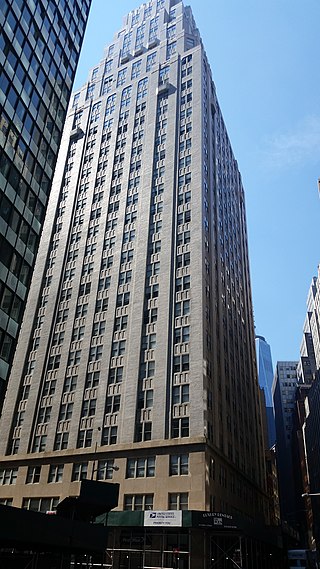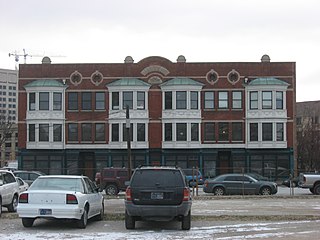
The Baker, also known as Massala, is a historic apartment building located at Indianapolis, Indiana. It was built in 1905, and is a three-story, 10-bay by 12 bay, Classical Revival style brick building with Queen Anne style design elements. It has limestone detailing and features paired two-story bay windows on the upper floors.

The Colonial is a historic apartment building located at Indianapolis, Indiana, United States. It was built in 1900, and is a three-story, eight bay by ten bay, Classical Revival style yellow brick building. It features a variety of terracotta decorative elements and two-story bay windows on the upper floors.

The McKay is a historic apartment building in Indianapolis, Indiana. It was built in 1924, and is a three-story, trapezoidal shaped, Art Deco style brown cinder brick and concrete building on a raised basement. It has a one-story entrance foyer addition and Art Deco bas-relief carvings.

Cornelia–Putnam Historic District is a national historic district in Ridgewood, Queens, New York. It includes 87 contributing buildings built between 1907 and 1922. They consist of two story, flat front brick rowhouse dwellings with one apartment per floor and three story tenements with two apartments per floor. They are constructed of yellow and amber brick with brownstone trim.

116 John Street is a historic office tower at the southwest corner of John Street and Pearl Street in the Financial District of Lower Manhattan in New York City. It was built in 1931, and is a 35-story brick and terra cotta building consisting of a three-story base, a 19-story shaft, and 12 upper stories that recede in a series of setbacks. The building features Art Deco style design elements at the recessed entrances and in the lobby. Built as a speculative office building for insurance companies, the building interior was rehabilitated in 2013 and some floors converted to apartments.
Lincoln School is a historic elementary school building located at Hornell, Steuben County, New York. It was built in 1923–1924, and is a three-story, Neoclassical revival style dark brick building. It has a flat roof and brick and terra cotta trim. Attached to the main block is a two-story addition containing a combined gymnasium and auditorium. It served as a neighborhood elementary school until 1979 and as an office building until 2012.

The Alexandra, also known as Lockerbie Court, is a historic apartment building located at Indianapolis, Indiana. It was built in 1902, and is a three-story, red brick and grey limestone building on a raised basement with Georgian Revival style detailing. It features six three-story polygonal bay windows on the front facade.

The Oxford is a historic apartment building located at Indianapolis, Indiana. It was built in 1902, and is a three-story, six bay by ten bay, orange brick and limestone building. The entrance features a semi-elliptical rusticated voussoir arch with two Ionic order pilasters.

The Harriett was a historic apartment building located at Indianapolis, Indiana. It was built about 1905, and was a three-story, "U"-shaped, Classical Revival style yellow brick and grey limestone building. It has been demolished.

The Lodge is a historic apartment building located at Indianapolis, Indiana. It was built in 1905, and is a three-story, three-bay, rectangular, Georgian Revival style red brick building. It features a limestone entrance portico with Ionic order columns and three-story bay windows.

The Massachusetts is a historic apartment building located at Indianapolis, Indiana. It was built in 1905, and is a three-story, yellow brick and limestone building. The first floor has commercial storefronts and the two upper stories have four plain Tuscan order pilasters.

The Plaza is a historic apartment building located at Indianapolis, Indiana. It was built in 1907, and is a three-story, "U"-shaped, glazed orange brick and grey limestone building. It features a full facade Renaissance Revival style entrance with Ionic order columns and polygonal bay windows on the upper stories.

The Grover is a historic apartment building located at Indianapolis, Indiana. It was built in 1914, and is a three-story, "I"-shaped, red brick building. It features a recessed entrance with limestone voussoir arch, bay windows on the upper stories, and a limestone frieze.

The Chadwick was a historic apartment building located at Indianapolis, Indiana. It was built in 1925, and was a three-story, five-bay, I-shaped, Georgian Revival style buff brick building with limestone detailing. It featured Tuscan order engaged columns at the entrance. It was destroyed by fire in January 2011.

The Alameda is a historic apartment building located at Indianapolis, Indiana. It was built about 1925, and is a three-story, rough cast buff brick building. It has commercial storefronts on the first floor. It features distinctive spandrels with basketweave pattern brickwork.

The Devonshire is a historic apartment building located at Indianapolis, Indiana. It was built in 1929, and is a three-story, three bay by nine bay, Tudor Revival style brown wire cut brick building. It features a recessed central entrance bay, limestone arched entrance, and brick and stone checkerwork at the third floor level.

Delaware Flats is a historic apartment building located at Indianapolis, Indiana. It was built in 1887, and is a three-story, ten bay wide, Classical Revival style painted brick and limestone building. The first floor has commercial storefronts with cast iron framing. The upper stories feature two-story blank arches with Corinthian order pilasters.

The Martens is a historic apartment building located at Indianapolis, Indiana. It was built in 1900, and is a three-story, 19 bay wide, brick building. It has commercial storefronts on the first floor with Classical Revival style cast iron pilaster posts and supporting "I" beam framing. It features two-story projecting bays on the upper stories.

Buffalo Public School No. 24, also known as Public School 59, is a historic school building located in the Broadway-Fillmore neighborhood of Buffalo, Erie County, New York. The original section was built in 1901, and is a three-story, seven bay, "I"-shaped, red brick building over a raised basement with Renaissance Revival detailing. The building incorporates sandstone, terra cotta, and pressed metal details. It was the first school to offer special education within the City of Buffalo school system. The school has been redeveloped as an apartment building.

The Rae Flats and The Raleigh, also known as The Phoenix; The Hotel Raleigh; The Tudor Arms; The Phoenix Apartments, are two historic apartment buildings located in the Allentown neighborhood of Buffalo, Erie County, New York. The Rae was built about 1892, and is a three-story, polychromatic brick building over a raised basement with Norman inspired detailing. The Rae houses a total of seven apartments. The Raleigh was built about 1896 as a Jewish clubhouse and converted to apartments in 1901. It is a four-story, Romanesque Revival style brick building that houses 28 apartments.























